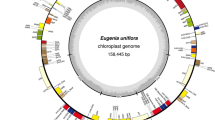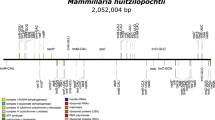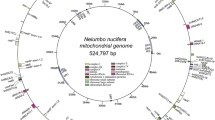Abstract
Plants have large and complex mitochondrial genomes in comparison to other eukaryotes. In bryophytes, the mitochondrial genomes exhibit a mixed mode of conservative and dynamic evolution. Here, we sequenced the complete mitochondrial genome from hornwort Phaeoceros laevis, to investigate the level of conservation in mitochondrial genome evolution within hornworts. The circular molecule consists of 209,482 base pairs and represents the largest known mitochondrial genome of bryophytes. It contains 30 protein genes, 3 rRNA genes, and 21 tRNA genes, with 34 cis-spliced group II introns disrupting 16 protein genes. There are 11 pseudogenes in this genome, and nine of them are shared with the other fully sequenced hornwort chondriome from Megaceros aenigmaticus, a distant relative of P. laevis. These pseudogenes were likely formed during an early stage of hornwort evolution. The two hornwort chondriomes differ by four inversions and translocations, seven genes, and four introns in the genome structure and organization. At the sequence level, they are very similar, with the identity values ranging mostly from 80 to 95% in intergenic spacers, introns, and exons. These data indicate that mitochondrial genome evolution in hornworts is less conservative than in liverworts, but has not reached the dynamic level as seen in seed plants.


Similar content being viewed by others
References
Adams KL, Qiu YL, Stoutemyer M, Palmer JD (2002) Punctuated evolution of mitochondrial gene content: high and variable rates of mitochondrial gene loss and transfer to the nucleus during angiosperm evolution. Proc Natl Acad Sci USA 99:9905–9912
Allen JO, Fauron CM, Minx P, Roark L, Oddiraju S, Lin GN, Meyer L, Sun H, Kim K, Wang CY, Du FY, Xu D, Gibson M, Cifrese J, Clifton SW, Newton KJ (2007) Comparisons among two fertile and three male-sterile mitochondrial genomes of maize. Genetics 177:1173–1192
Altschul SF, Gish W, Miller W, Myers EW, Lipman DJ (1990) Basic local alignment search tool. J Mol Biol 215:403–410
Andre C, Levy A, Walbot V (1992) Small repeated sequences and the structure of plant mitochondrial genomes. Trends Genet 8:128–132
Chaw SM, Shih ACC, Wang D, Wu YW, Liu SM, Chou TY (2008) The mitochondrial genome of the gymnosperm Cycas taitungensis contains a novel family of short interspersed elements, Bpu sequences, and abundant RNA editing sites. Mol Biol Evol 25:603–615
Dombrovska O, Qiu Y-L (2004) Distribution of introns in the mitochondrial gene nad1 in land plants: phylogenetic and molecular evolutionary implications. Mol Phylogen Evol 32:246–263
Doyle JJ, Doyle JS (1987) A rapid DNA isolation procedure for small quantities of fresh leaf tissue. Phytochem Bull 19:11–15
Duff RJ, Villarreal JC, Cargill DC, Renzaglia KS (2007) Progress and challenges toward developing a phylogeny and classification of the hornworts. Bryologist 110:214–243
Gray MW, Lang BF, Burger G (2004) Mitochondria of protists. Annu Rev Genet 38:477–524
Groth-Malonek M, Pruchner D, Grewe F, Knoop V (2005) Ancestors of trans-splicing mitochondrial introns support serial sister group relationships of hornworts and mosses with vascular plants. Mol Biol Evol 22:117–125
Groth-Malonek M, Wahrmund U, Polsakiewicz M, Knoop V (2007) Evolution of a pseudogene: Exclusive survival of a functional mitochondrial nad7 gene supports Haplomitrium as the earliest liverwort lineage and proposes a secondary loss of RNA editing in Marchantiidae. Mol Biol Evol 24:1068–1074
Guo X, Zhang Z, Gerstein MB, Zheng D (2009) Small RNAs originated from pseudogenes: cis- or trans-acting? PLoS Comput Biol 5:e1000449
Handa H (2003) The complete nucleotide sequence and RNA editing content of the mitochondrial genome of rapeseed (Brassica napus L.): comparative analysis of the mitochondrial genomes of rapeseed and Arabidopsis thaliana. Nucleic Acids Res 31:5907–5916
Kelch DG, Driskell A, Mishler BD (2004) Inferring phylogeny using genomic characters: a case study using land plant plastomes. In: Goffinet B, Hollowell V, Magill R (eds) Molecular systematics of bryophytes. Missouri Botanical Garden Press, St. Louis, pp 3–11
Knoop V (2004) The mitochondrial DNA of land plants: peculiarities in phylogenetic perspective. Curr Genet 46:123–139
Kubo N, Arimura S-I (2009) Discovery of a functional rpl10 gene in diverse plant mitochondrial genomes and its functional replacement by a nuclear gene for chloroplast RPL10 in two lineages of angiosperms. DNA Res (in press)
Kugita M, Yamamoto Y, Fujikawa T, Matsumoto T, Yoshinaga K (2003) RNA editing in hornwort chloroplasts makes more than half the genes functional. Nucleic Acids Res 31:2417–2423
Kurtz S, Choudhuri JV, Ohlebusch E, Schleiermacher C, Stoye J, Giegerich R (2001) REPuter: The manifold applications of repeat analysis on a genomic scale. Nucleic Acids Res 29:4633–4642
Lang BF, Burger G, Okelly CJ, Cedergren R, Golding GB, Lemieux C, Sankoff D, Turmel M, Gray MW (1997) An ancestral mitochondrial DNA resembling a eubacterial genome in miniature. Nature 387:493–497
Lenz H, Rüdinger M, Volkmar U, FIscher S, Herres S, Grewe F, Knoop V (2009) Introducing PREPACT—the plant RNA editing prediction and analysis computer tool and an update on RNA editing site nomenclature. Curr Genet (in press)
Li L, Wang B, Liu Y, Qiu Y-L (2009) The complete mitochondrial genome sequence of the hornwort Megaceros aenigmaticus shows a mixed mode of conservative yet dynamic evolution in early land plant mitochondrial genomes. J Mol Evol 68:665–678
Lohse M, Drechsel O, Bock R (2007) OrganellarGenomeDRAW (OGDRAW)—a tool for the easy generation of high-quality custom graphical maps of plastid and mitochondrial genomes. Curr Genet 52:267–274
Lowe TM, Eddy SR (1997) tRNAscan-SE: a program for improved detection of transfer RNA genes in genomic sequence. Nucleic Acids Res 25:955–964
Malek O, Knoop V (1998) Trans-splicing group II introns in plant mitochondria: The complete set of cis-arranged homologs in ferns, fern allies, and a hornwort. RNA 4:1599–1609
Michel F, Dujon B (1983) Conservation of RNA secondary structures in two intron families including mitochondrial-, chloroplast- and nuclear-encoded members. EMBO J 2:33–38
Oda K, Yamato K, Ohta E, Nakamura Y, Takemura M, Nozato N, Akashi K, Kanegae T, Ogura Y, Kohchi T, Ohyama K (1992) Gene organization deduced from the complete sequence of liverwort Marchantia polymorpha mitochondrial DNA—a primitive form of plant mitochondrial genome. J Mol Biol 223:1–7
Palmer JD (1985) Comparative organization of chloroplast genomes. Annu Rev Genet 19:325–354
Palmer JD, Adams KL, Cho YR, Parkinson CL, Qiu YL, Song KM (2000) Dynamic evolution of plant mitochondrial genomes: mobile genes and introns and highly variable mutation rates. Proc Natl Acad Sci USA 97:6960–6966
Pruchner D, Beckert S, Muhle H, Knoop V (2002) Divergent intron conservation in the mitochondrial nad2 gene: signatures for the three bryophyte classes (Mosses, liverworts, and hornworts) and the lycophytes. J Mol Evol 55:265–271
Qiu Y-L (2008) Phylogeny and evolution of charophytic algae and land plants. J Syst Evol 46:287–306
Qiu Y-L, Cho YR, Cox JC, Palmer JD (1998) The gain of three mitochondrial introns identifies liverworts as the earliest land plants. Nature 394:671–674
Qiu Y-L, Li LB, Wang B, Chen ZD, Knoop V, Groth-Malonek M, Dombrovska O, Lee J, Kent L, Rest J, Estabrook GF, Hendry TA, Taylor DW, Testa CM, Ambros M, Crandall-Stotler B, Duff RJ, Stech M, Frey W, Quandt D, Davis CC (2006) The deepest divergences in land plants inferred from phylogenomic evidence. Proc Natl Acad Sci USA 103:15511–15516
Schuster RM (1992) The Hepaticae and Anthocerotae of North America, vol VI. Field Museum of Natural History, Chicago
Schuster W, Brennicke A (1994) The plant mitochondrial genome—physical structure, information content, RNA editing, and gene migration to the nucleus. Annu Rev Plant Physiol Plant Mol Biol 45:61–78
Steinhauser S, Beckert S, Capesius I, Malek O, Knoop V (1999) Plant mitochondrial RNA editing. J Mol Evol 48:303–312
Terasawa K, Odahara M, Kabeya Y, Kikugawa T, Sekine Y, Fujiwara M, Sato N (2007) The mitochondrial genome of the moss Physcomitrella patens sheds new light on mitochondrial evolution in land plants. Mol Biol Evol 24:699–709
Thompson JD, Gibson TJ, Plewniak F, Jeanmougin F, Higgins DG (1997) The CLUSTAL_X windows interface: flexible strategies for multiple sequence alignment aided by quality analysis tools. Nucleic Acids Res 25:4876–4882
Turmel M, Otis C, Lemieux C (2002) The chloroplast and mitochondrial genome sequences of the charophyte Chaetosphaeridium globosum: Insights into the timing of the events that restructured organelle DNAs within the green algal lineage that led to land plants. Proc Natl Acad Sci USA 99:11275–11280
Turmel M, Otis C, Lemieux C (2003) The mitochondrial genome of Chara vulgaris: Insights into the mitochondrial DNA architecture of the last common ancestor of green algae and land plants. Plant Cell 15:1888–1903
Unseld M, Marienfeld JR, Brandt P, Brennicke A (1997) The mitochondrial genome of Arabidopsis thaliana contains 57 genes in 366, 924 nucleotides. Nat Genet 15:57–61
Wang B, Xue J-Y, Li L, Liu L, Qiu Y-L (2009) The complete mitochondrial genome sequence of the liverwort Pleurozia purpurea reveals extremely conservative mitochondrial genome evolution in liverworts. Curr Genet 55:601–609
Zhang Z, Gerstein M (2004) Large-scale analysis of pseudogenes in the human genome. Curr Opin Genet Dev 14:328–335
Acknowledgments
We would like to thank David K. Smith and Ken D. McFarland for help with obtaining the plant material, and Volker Knoop and Jeffery D. Palmer for valuable suggestions. This work was supported by a NSF Grant (DEB 0332298) to YLQ.
Author information
Authors and Affiliations
Corresponding author
Additional information
Communicated by R. Bock.
J.-Y. Xue and Y. Liu authors contributed equally to this work.
The Phaeoceros laevis mitochondrial genome sequence reported in this study has been deposited in GenBank under the accession # GQ376531.
Electronic supplementary material
Below is the link to the electronic supplementary material.
Rights and permissions
About this article
Cite this article
Xue, JY., Liu, Y., Li, L. et al. The complete mitochondrial genome sequence of the hornwort Phaeoceros laevis: retention of many ancient pseudogenes and conservative evolution of mitochondrial genomes in hornworts. Curr Genet 56, 53–61 (2010). https://doi.org/10.1007/s00294-009-0279-1
Received:
Revised:
Accepted:
Published:
Issue Date:
DOI: https://doi.org/10.1007/s00294-009-0279-1




